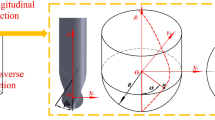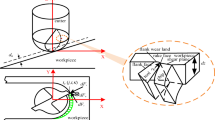Abstract
The quality of a workpiece depends on the time-varying characteristics of the tool performance. Tool wear is an important factor that affects the serviceability of a tool. However, most existing models do not fully contain the tool design and processing parameters and do not focus on the time-varying characteristics of wear. In this paper, the wear distribution characteristics of a ball-end mill were investigated by analysing the position function in the milling life model, and the geometric model of the wear volume was proposed based on the principle of calculus. By geometric and physical modelling, the tool design and machining parameters were completely introduced in the model, and the time variable is introduced when solving the wear rate. After the models and assumptions are validated, the factors affecting wear are cross-analysed and discussed through simulation. Wear models including time variables, tool design, and milling parameters are obtained, which can be used directly for tool design and analysis. This research provides a basis for the tool analytical design.















Similar content being viewed by others
References
Abele E, Hasenfratz C, Bücker M (2017) Modeling of process forces with respect to technology parameters and tool wear in milling Ti6Al4V. Prod Eng 11(3):285–294
Yue C, Gao H, Liu X, Liang SY (2018) Part functionality alterations induced by changes of surface integrity in metal milling process: a review. Appl Sci 8:2550
Eshi U (1982) Cutting and grinding processing. Mechanical Industry Press, China
Ning L, Veldihuis SC (2006) Mechanistic modeling of ball end milling including tool wear. J Manuf Process 8(1):21–28
Zhang C, Zhou L, An L (2008) Modeling and error compensation for tool wear of ball-end milling cutter. Aust J Mech Eng 44(2):207–212
Zhang C, Zhou L (2013) Modeling of tool wear for ball end milling cutter based on shape mapping. Int J Interact Des Manuf 7(3):171–181
Khan MR (2011) Geometric modeling, design and analysis of custom-engineered milling cutters. Jabalpur
Huang Y, Liang SY (2004) Modeling of CBN tool flank wear progression in finish hard turning. J Manuf Sci Eng 126(1):98–106
Li KM, Liang SY (2012) Flank wear model for near dry turning under built-up edge effect. J Chn Mech Eng 33(2):123–132
Teitenberg TM, Bayoumi AE, Yucesan G (1992) Tool wear modeling through an analytic mechanistic model of milling processes. Wear 154(2):287–304
Okamoto Y, Yazawa T, Kato T, Nishida K, Moriyama S, Maeda Y et al (2017) Study on tool wear in-process estimation for ball end mill using rotation control air turbine spindle. Key Eng Mater 749:94–100
Mou T (2009) Research on tool wear of high speed milling Ti6Al4V. J Shandong Univ, Jinan
Jiang B, Zheng M, Yang S (2003) Establishment of mathematical model for service life of ball-end milling cutter. Manuf Technol Mach Tools 8:9–11
Li Y, Deng J, Shi L (2007) Tool materials for high speed machining of titanium alloys. Manuf Technol Mach Tools 8:24–27
Sun Y, Sun J, Li J (2016) Finite element prediction analysis of tool wear in titanium milling. Aust J Mech Eng 52:193–201
Rabinowicz E, Dunn LA, Russell PG (1961) A study of abrasive wear under three-body conditions. Wear 4(5):345–355
Lee M (1983) High temperature hardness of tungsten carbide. Metall Trans A 14:1625–1629
Guo B, Zhang L, Cao L, Zhang T, Jiang F, Yan L (2018) The correction of temperature-dependent Vickers hardness of cemented carbide base on the developed high-temperature hardness tester. J Mater Process Technol 255:426–433
Milman YV, Luyckx S, Northrop IT (1999) Influence of temperature, grain size and cobalt content on the hardness of WC–Co alloys. Int J Refract Met Hard Mater 17:39–44
Genghuang H (2013) Research on high-efficiency cutting and tool technology for large barrel sections. Harbin Univ Sci Technol, Harbin
Milman YV, Chugunova S, Goncharuck V, Luyckx S, Northrop IT (1997) Low and high temperature hardness of WC-6 wt%Co alloys. Int J Refract Met Hard Mater 15:97–101
Kramer BM, Judd PK (1985) Computational design of wear coatings. J Vac Sci Technol A Vac Surf Films 3:2439–2444
Tang L, Xie L, Ma S et al (2010) Experimental research on machining TC4 titanium alloy engine blade ball knife. Manuf Technol Mach Tools 2:92–94
Fick A (1995) On liquid diffusion. J Membr Sci 100(1):33–38
Miller FP, Vandome AF, McBrewster J (2010) Fick’s laws of diffusion. Alphascript Publishing, Germany
Ezugwu EO, Wang ZM (1997) Titanium alloys and their machinability—a review. J Mater Process Technol 68:262–274
Sui SC, Feng PF, Mou WP (2016) Temperature modeling analysis for milling of titanium alloy. Key Eng Mater 693:928–935
Li L, Chang H, Wang M, Zuo DW, He L (2004) Temperature measurement in high speed milling Ti6Al4V. Key Eng Mater 259:804–808
Ji S, Ni J, Zhan B et al (2016) Orthogonal experimental study on milling temperature of TC4 titanium alloy. Manuf Technol Mach Tools 2:91–93
Yang Y, Zhao W, Li L et al (2014) Experimental study on cutting force and cutting temperature of Ti6Al4V titanium alloy in large feed milling. Aviat Precis Manufac Technol 50:34–37
Cui D, Zhang D, Wu B, Luo M (2017) An investigation of tool temperature in end milling considering the flank wear effect. Int J Mech Sci 131:613–624
Han M, Li Y, Zhao W (2008) Experimental study on cutting temperature of Ti6Al4V titanium alloy during high speed cutting. Tool Technol 42:10–13
Attanasio A, Ceretti E, Rizzuti S, Umbrello D, Micari F (2008) 3D finite element analysis of tool wear in machining. CIRP Ann Manuf Technol 57:61–64
Anto T, Anil PM (2013) An analysis on the influence of temperature on the sliding wear of components finished by grinding and milling processes. Proc Int Conf Energ Effic Technol Sustain
Komanduri R (1982) Some clarifications on the mechanics of chip formation when machining titanium alloys. Wear 76:15–34
Jiang H (2005) A cobalt diffusion based model for predicting crater wear of carbide tools in machining titanium alloys. J Eng Mater Technol 127:136–144
Yue C, Gao H, Liu X, Liang SY, Wang L (2019) A review of chatter vibration research in milling. Chin J Aeronaut 32:1–28
Author information
Authors and Affiliations
Corresponding author
Additional information
Publisher’s note
Springer Nature remains neutral with regard to jurisdictional claims in published maps and institutional affiliations.
Rights and permissions
About this article
Cite this article
Zhao, Z., Liu, X., Yue, C. et al. Time-varying analytical model of ball-end milling tool wear in surface milling. Int J Adv Manuf Technol 108, 1109–1123 (2020). https://doi.org/10.1007/s00170-019-04783-y
Received:
Accepted:
Published:
Issue Date:
DOI: https://doi.org/10.1007/s00170-019-04783-y




